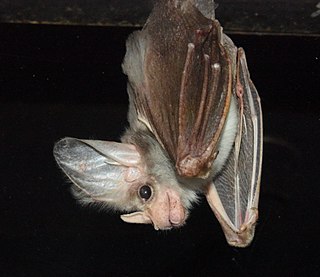
Emballonuridae is a family of microbats, many of which are referred to as sac-winged or sheath-tailed bats. They are widely distributed in tropical and subtropical regions around the world. The earliest fossil records are from the Eocene.

The ghost bat is a species of bat found in northern Australia. The species is the only Australian bat that preys on large vertebrates – birds, reptiles and other mammals – which they detect using acute sight and hearing, combined with echolocation, while waiting in ambush at a perch. The wing membrane and bare skin is pale in colour, their fur is light or dark grey over the back and paler at the front. The species has a prominent and simple nose-leaf, their large ears are elongated and joined at lower half, and the eyes are also large and dark in colour. The first description of the species was published in 1880, its recorded range has significantly contracted since that time.

Micronomus norfolkensis is a species of molossid bat, a family of flying mammals. The bat is endemic to Australia, where it occurs from southeastern Queensland to eastern New South Wales. They are the sole species of genus Micronomus and referred to by variations on east-coast free-tailed bat.
The northern cave bat is a vesper bat that occurs throughout most of Australia.
Finlayson's cave bat is a species of vesper bat found only in Australia.

The yellow-bellied sheath-tailed bat, also known as the yellow-bellied sheathtail or yellow-bellied pouched bat, is a microbat species of the family Emballonuridae found extensively in Australia and less commonly in parts of Papua New Guinea.

Saccolaimus is a genus of the family Emballonuridae, small insectivorous bats with distinctive sheathtails and pouches at the wrist.

The Papuan sheath-tailed bat is a species of bat in the family Emballonuridae which occurs at the Cape York Peninsula and New Guinea. The poorly known species hunts in open forests for night flying insects.

The naked-rumped pouched bat, also known as the pouched tomb bat, is a species of sac-winged bat in the family Emballonuridae.

Taphozous is a genus of the family Emballonuridae. The wide distribution of the genus includes several regions of Australia, Indonesia, Papua New Guinea and Africa. Taphozous comes from the Greek τάφος, meaning "a tomb". The common names for species include variants on sac-winged, sheathtail, or tomb bats.

Hildegarde's tomb bat is a species of sac-winged bat in the family Emballonuridae. It is found near the coast in Kenya and Tanzania where it feeds in tropical dry forests and roosts in caves. It is a diurnal species and the International Union for Conservation of Nature has assessed its conservation status as "endangered". The specific name hildegardeae was given in honour of anthropologist Hildegarde Beatrice Hinde.

Hill's sheath-tailed bat is a bat of the family Emballonuridae. They are found in the deserts of central Australia.

The Arnhem sheath-tailed bat, species is an emballonurid bat found at the Top End of Australia. The species is also referred to as the white-striped sheathtail for the distinguishing marks at the flank, a feature observable beneath the wing when the animal is in flight. Records of the species are rare.

The Mauritian tomb bat is a species of sac-winged bat in the family Emballonuridae that is found in central and southern Africa and Madagascar. It was discovered in 1818 by Étienne Geoffroy Saint-Hilaire, and is characterized by an all-white ventral surface, grizzled dorsal coloration, and conical face. It has exceptionally good eyesight, a trait which is common in old world bats and enables it to find roosting locations. It has adapted itself to a wide range of habitats including subarid scrub to semi-tropical savanna and can be found throughout much of Africa south of the Sahara, including many of the surrounding islands. They often seek out refuge in cool dry areas. Mauritian tomb bats help control pest populations, including insects that carry human diseases. These bats tend to be nocturnal hunters and their normal prey consists of moths, butterflies, and termites. Not prone to large-scale roosting, T. mauritianus is most often spotted on the sides of buildings or on the trunks of trees in groups of around five individuals. They breed on average once or twice a year and rear usually one pup, though twins are occasionally reported. They usually deposit their hungry offspring in areas where they can feed voraciously, most often in berry bushes. This species is listed as least concern on the IUCN Red List due their wide distribution and stable population.

The naked-rumped tomb bat is a species of sac-winged bat in the family Emballonuridae. Found in northern Africa, the Middle East, and southeastern Asia, its natural habitats are dry savanna, subtropical or tropical dry shrubland and forests, caves, and arid areas.

Troughton's sheath-tailed bat is a species of sheathtail bat in the family Emballonuridae, found only in Australia.















